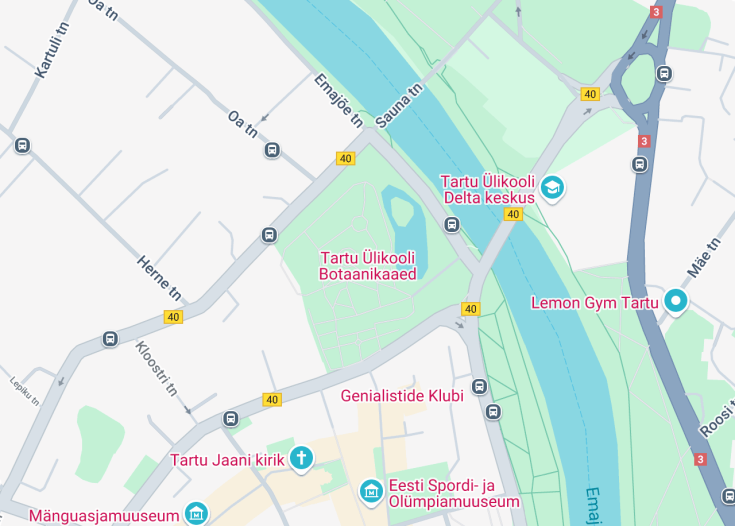The University of Tartu Botanical Garden, established in 1803, represents an exquisite fusion of nature and education in Tartu, Estonia. This renowned botanical haven is not only a place for leisurely strolls but also serves as a vital center for botanical research and conservation. Visitors can explore diverse plant species in beautifully designed landscapes, contributing to a rich understanding of global flora.
When visiting the University’s botanical garden, consider arriving early in the morning to enjoy the tranquility of the landscape. The early hours provide an opportunity to witness the garden’s vibrant flora in peaceful surroundings, enhancing the overall experience.
For an enriching experience, participate in one of the guided tours offered at the Botanical Garden of the University of Tartu. These tours provide insightful information about the garden’s unique plant collections and their ecological significance, making your visit both informative and delightful.
University of Tartu Botanical Garden: A Sanctuary of Nature’s Splendor
The University of Tartu Botanical Garden in Tartu, Estonia, stands as a cherished refuge for both flora enthusiasts and casual visitors alike. Nestled in the heart of Tartu, this botanical haven spans over 13 hectares, showcasing an impressive collection of plant species from around the world. Visitors can stroll through meticulously landscaped gardens, each themed to highlight different ecological regions and plant types. The garden’s diverse array includes vibrant flower beds, towering trees, and serene water features that create a peaceful ambiance perfect for relaxation and contemplation. Educational displays and informational plaques provide insights into the botanical diversity and the importance of plant conservation. Seasonal events and guided tours offer engaging ways to explore the garden’s rich heritage and ongoing research initiatives. Whether you’re a local resident or a tourist, the University of Tartu Botanical Garden offers a unique opportunity to connect with nature, appreciate botanical artistry, and enjoy a tranquil escape from the bustling city life.
Discover Engaging Activities and Scenic Highlights at the Botanical Garden
The Botanical Garden offers a variety of activities and attractions to enhance your visit. Take a leisurely walk along the themed paths, each designed to showcase different plant ecosystems and horticultural styles. For those interested in photography, the garden provides numerous picturesque spots perfect for capturing the beauty of nature.
Guided Tours
Join an expert-led tour to gain deeper insights into the garden’s diverse plant collections and ongoing research projects.
Seasonal Exhibits
Experience the garden’s seasonal transformations with special exhibits featuring blooming flowers in spring, lush greenery in summer, colorful foliage in autumn, and serene winter landscapes.
Educational Workshops
Participate in hands-on workshops and educational programs designed for all ages, fostering a greater understanding of botany and environmental stewardship. Additionally, the garden hosts cultural events and festivals throughout the year, providing a vibrant community space for learning and enjoyment.
The Historic Greenhouse: Preserving Botanical Heritage
One of the University of Tartu Botanical Garden’s most notable features is its historic greenhouse, a testament to the garden’s long-standing commitment to plant conservation and research. This architectural gem houses a diverse collection of tropical and subtropical plants, offering visitors a glimpse into ecosystems far beyond Estonia’s natural climate. The greenhouse environment meticulously replicates conditions necessary for the survival of delicate species, allowing for both public display and scientific study. Over the years, it has become a vital center for botanical research, contributing to the preservation of endangered plant species and the advancement of horticultural knowledge. The greenhouse not only serves as an educational resource but also as a cultural landmark, reflecting the garden’s dedication to fostering a deeper appreciation for the natural world.
Explore the Enchanting University of Tartu Botanical Garden in Tartu
The University of Tartu Botanical Garden is a captivating destination perfect for nature enthusiasts, families, and scholars alike. Visitors can expect to immerse themselves in a diverse collection of plant species, beautifully landscaped gardens, and serene walking paths. Whether you’re interested in botanical research or simply seeking a peaceful retreat, this garden offers a unique experience that caters to all. It seamlessly integrates into broader tourist itineraries in Tartu, making it an ideal stop alongside museums, historic sites, and charming cafes. Professional guides often share insider tips, such as the best spots for photographing rare plants or the optimal times to witness seasonal blooms. Don’t miss the chance to explore hidden corners and discover the garden’s rich history and ongoing botanical endeavors.
Optimal Seasons to Visit the University of Tartu Botanical Garden
The Botanical Garden of the University of Tartu shines throughout the year, but the best times to visit are during the spring and summer months. In spring, vibrant blossoms and lush greenery create a picturesque setting, while summer offers a full display of diverse plant life under the warm sun.
Annual Flower Festival
One of the most anticipated events is the annual Flower Festival, held every May. This event showcases an array of seasonal flowers, live demonstrations, and guided tours, providing an exceptional opportunity to experience the garden’s beauty at its peak.
Accessibility and Petitions
The University Botanical Gardens prioritize accessibility, ensuring that all visitors can enjoy the facilities with ease.
Accessibility
Limitations
- No pets allowed, except for service animals.
- Restricted access to certain sensitive plant areas to protect rare species.
- Photography may be limited in specific sections to preserve the environment.
Notes to visitors
- Visitors are encouraged to wear comfortable footwear for walking.
- Picnicking is permitted in designated areas only.
- Mobile phone use should be respectful of other guests’ experience.
General Information
Details for your visit to the University of Tartu Botanical Garden
Location
The Botanical Garden is conveniently situated near the heart of Tartu, adjacent to several key landmarks and easily accessible from major transport hubs.
Address:
Katriina tn 4 – 51014 Tartu, 51014
Visiting Information
The Botanical Garden welcomes visitors daily from dawn till dusk, offering ample time to explore its expansive grounds. For the best experience, plan your visit in the morning when the gardens are tranquil and the lighting is ideal for photography.
How to Reach the University of Tartu Botanical Garden
Getting to the University Botanical Gardens in Tartu is straightforward, with multiple transportation options available from the city center.
Car
The Botanical Garden can be easily reached by car. Parking is available at the nearby parking structure for a nominal fee. Additionally, several public parking lots are situated within walking distance.
| Route | Distance | Travel time |
|---|---|---|
| From Tartu Central Station | 2 miles (3.2 km) | 10 minutes |
| From University of Tartu Main Campus | 1 mile (1.6 km) | 5 minutes |
| From Vanemuine Music Theatre | 1.5 miles (2.4 km) | 8 minutes |
Public Transportation
The Botanical Garden is well-connected by Tartu’s public bus system. Several bus lines stop within a short walking distance, making it convenient for both locals and tourists.
| Route | Distance | Travel time |
|---|---|---|
| Bus Line 2 | 2 miles (3.2 km) | 15 minutes |
| Bus Line 5 | 2 miles (3.2 km) | 15 minutes |
| Bus Line 7 | 2 miles (3.2 km) | 15 minutes |
Nearby Attractions
- Estonian National Museum – 0.5 miles (0.8 km)
- Tartu Old Town – 1 mile (1.6 km)
- Toome Hill Park – 1.2 miles (1.9 km)
- Ruigu Hill and Observatory – 1.5 miles (2.4 km)
- Emajõgi River Promenade – 1.7 miles (2.7 km)
- Tartu Toy Museum – 2 miles (3.2 km)
- St. John’s Church – 2.2 miles (3.5 km)
- Ala Street Shopping District – 2.5 miles (4 km)
- Julita Museum Estate – 3 miles (4.8 km)
- Ülikooli Stadium – 3.5 miles (5.6 km)
- Tartu Art Museum – 3.8 miles (6.1 km)
- Kumari Quarter – 4 miles (6.4 km)
Common questions
What types of plants are found in the University of Tartu Botanical Garden?
- Arctic and Alpine Plants: Species adapted to cold climates, featuring resilient flora such as moss campion and alpine forget-me-nots.
- Tropical Greenhouse: A range of tropical plants including orchids, bromeliads, and ferns thrive in controlled environments.
- Medicinal Plants: A comprehensive collection showcasing plants used in traditional and modern medicine, such as ginkgo biloba and echinacea.
- Conifers and Deciduous Plants: Various tree species, including pines, spruces, maples, and oaks, illustrating the region’s biodiversity.
- Herbaceous Plants: An array of flowering species that provide vibrant displays during different seasons.
Overall, the garden serves as a living laboratory for botanical research and education, offering visitors an opportunity to appreciate the vast diversity of plant life.
Are there any rare or endangered plant species in the University of Tartu Botanical Garden?
- Estonian Endemics: Plants native to Estonia that are not found naturally elsewhere, such as the Tartu harebell.
- Internationally Endangered Species: Includes species like the lady’s slipper orchid (Cypripedium calceolus) and the ghost orchid (Dendrophylax lindenii).
- Conservation Collections: Dedicated sections for preserving plant genetic diversity, ensuring that endangered species are maintained for future generations.
The garden collaborates with global botanical institutions to participate in seed exchange programs and reintroduction projects, playing an active role in the preservation of threatened plant life.
What educational programs does the University of Tartu Botanical Garden offer?
- Guided Tours: Educational walks led by knowledgeable staff, focusing on plant biology, ecology, and conservation.
- Workshops and Seminars: Interactive sessions covering topics like sustainable gardening, plant taxonomy, and environmental stewardship.
- School Programs: Designed for primary and secondary students, including hands-on activities and curriculum-aligned lessons.
- University Courses: Integration with academic programs, offering practical experiences for students in botany, ecology, and related fields.
- Public Lectures: Open-to-public talks by experts on various botanical and environmental topics.
These programs aim to foster a deeper understanding of plant sciences and promote environmental awareness among participants.
Is there a greenhouse in the University of Tartu Botanical Garden, and what does it contain?
- Tropical Greenhouse: Contains humidity- and temperature-loving plants like orchids, bromeliads, and various tropical ferns.
- Cactus and Succulent House: Showcases diverse cacti and succulents adapted to arid conditions, including rare species from desert ecosystems.
- Orchidarium: Dedicated specifically to orchids, displaying a stunning variety of species with intricate flowers.
- Apiary: An integrated feature where visitors can observe pollination processes and learn about the importance of bees in ecosystems.
These greenhouses provide visitors with the opportunity to experience plant diversity beyond the temperate outdoor collections, enabling year-round enjoyment and study.
Can visitors participate in any conservation projects at the University of Tartu Botanical Garden?
- Community Planting: Opportunities for visitors to help plant native species or contribute to the expansion of themed gardens.
- Citizen Science Projects: Engagement in data collection and monitoring for ongoing research studies, such as tracking plant health and phenology.
- Seed Bank Assistance: Volunteers can assist in managing the seed bank, including harvesting seeds from specific plants for preservation.
- Educational Outreach: Participating in workshops or leading guided tours helps spread awareness about plant conservation.
These projects not only support the garden’s conservation goals but also foster a sense of community involvement and education among visitors.
Are there any notable architectural features or sculptures within the University of Tartu Botanical Garden?
- Historic Greenhouses: Elegant glass structures from the 19th century that house diverse plant collections and serve as landmarks within the garden.
- Sculpture Installations: Art pieces by local and international artists strategically placed throughout the grounds, blending art with nature.
- Educational Pavilions: Structures designed for hosting workshops, lectures, and exhibitions related to botany and environmental studies.
- Water Features: Artificial ponds and fountains that provide habitats for aquatic plants and wildlife, while offering tranquil spots for visitors.
These features contribute to the aesthetic appeal of the garden and provide functional spaces for education and recreation.
What wildlife can be observed at the University of Tartu Botanical Garden?
- Birds: Species such as the European greenfinch, common kingfisher, and various migratory birds can be seen throughout the garden.
- Insects: Butterflies, bees, and dragonflies are frequently observed, particularly around flowering plants and water features.
- Mammals: Small mammals like voles and hedgehogs inhabit the garden’s green spaces, offering glimpses into their natural behavior.
- Amphibians: Frogs and newts may be found near ponds and marshy areas, especially during breeding seasons.
- Reptiles: Occasional sightings of lizards basking in sunlit areas of the garden.
The diverse habitats within the botanical garden support a rich ecosystem, making it an excellent location for observing both resident and visiting wildlife.
Is photography allowed in the University of Tartu Botanical Garden?
- Permitted Areas: Most outdoor and greenhouse areas are open to photography. However, certain sections may have restrictions to protect sensitive plant species or research areas.
- No Flash Photography: To ensure the well-being of plants and wildlife, the use of flash photography is discouraged in greenhouses and nocturnal animal habitats.
- Respect Privacy: Refrain from taking photos of other visitors without their consent to maintain a respectful environment.
- Commercial Use: For professional photography or commercial purposes, obtaining prior permission from garden administration is recommended.
- Drones: The use of drones is typically restricted to protect both plant life and visitor privacy. Check with the garden’s policy before operating a drone.
By adhering to these guidelines, visitors can enjoy photography while contributing to the garden’s preservation and the comfort of all guests.
Are there facilities for visitors with disabilities at the University of Tartu Botanical Garden?
- Accessible Paths: Paved and wide walkways throughout the garden allow easy navigation for those using wheelchairs or mobility scooters.
- Wheelchair Rentals: Available on request for visitors who may need assistance moving around the garden.
- Accessible Restrooms: Restroom facilities are designed to be accessible, equipped with necessary accommodations.
- Braille Signage: Informational signs in Braille are available to assist visually impaired visitors in navigating and learning about different plant species.
- Assistance Services: Staff members are trained to provide support and information to visitors with special needs upon request.
These facilities ensure that all guests can fully enjoy and explore the botanical garden without facing barriers.
How is the University of Tartu Botanical Garden involved in research and conservation?
- Scientific Research: Collaborates with academic institutions to conduct studies on plant taxonomy, ecology, genetics, and climate change impacts.
- Conservation Programs: Engages in the preservation of rare and endangered species, both locally and internationally, through seed banking and habitat restoration projects.
- Biodiversity Monitoring: Continuously surveys and tracks plant and animal populations within the garden to assess ecosystem health and inform conservation strategies.
- Public Education: Provides resources and programs to educate the public about the importance of biodiversity and sustainable practices.
- Collaborative Networks: Partners with global botanical gardens and conservation organizations to exchange knowledge, resources, and plant material.
These efforts position the botanical garden as a leader in botanical science and environmental stewardship, contributing to the global endeavor to understand and preserve plant life.
What seasonal changes can visitors expect to see at the University of Tartu Botanical Garden?
- Spring: Blossoming trees such as magnolias and cherry blossoms, vibrant flower beds featuring tulips and daffodils, and the emergence of new foliage.
- Summer: Lush greenery, blooming perennials, and an extended display of colorful flowers like roses and lilies, creating a lively and vibrant atmosphere.
- Autumn: Foliage transforms into a tapestry of reds, oranges, and yellows, with deciduous trees like maples and oaks showcasing their fall colors. Harvest-themed displays may also be featured.
- Winter: The garden presents a serene winter landscape with bare trees, snow-covered grounds, and winter-hardy plants. Greenhouses remain active, providing a contrast with tropical plants.
These seasonal changes not only enhance the garden’s aesthetic appeal but also offer varied experiences for repeat visitors throughout the year.
Are there any dining or refreshment options available at the University of Tartu Botanical Garden?
- Garden Café: Located centrally, the café offers a range of beverages including coffee, tea, and soft drinks, as well as light snacks such as pastries, sandwiches, and salads.
- Picnic Areas: Designated spots throughout the garden are available for visitors to enjoy their own meals amidst the natural surroundings. These areas are equipped with tables and benches.
- Vending Machines: Strategically placed vending machines provide convenient access to drinks and snacks for visitors on the go.
- Specialty Events: Occasionally, the garden hosts themed food stalls or pop-up restaurants during festivals and special events, offering a variety of culinary delights.
These amenities ensure that visitors can comfortably spend extended periods exploring the garden while having access to necessary refreshments.

Is the University of Tartu Botanical Garden in Tartu, Estonia Worth Visiting?
The University of Tartu Botanical Garden is a must-visit destination for anyone traveling to Tartu, Estonia. It boasts a diverse array of plant species, providing a serene environment perfect for nature lovers and those seeking a peaceful escape from the city’s hustle. The garden offers well-maintained paths and beautifully landscaped areas, making strolling a delightful experience. Additionally, it features informative exhibits and is an excellent spot for educational trips. However, during peak seasons, it can become crowded, which may detract from the tranquility some visitors seek. Overall, the botanical garden is a valuable attraction that combines natural beauty with educational opportunities, making it well worth a visit for tourists exploring Tartu.









